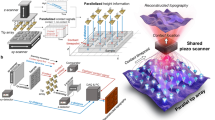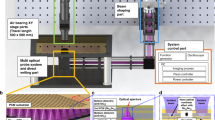Abstract
Lithography techniques are currently being developed to fabricate nanoscale components for integrated circuits, medical diagnostics and optoelectronics1,2,3,4,5,6,7. In conventional far-field optical lithography, lateral feature resolution is diffraction-limited8. Approaches that overcome the diffraction limit have been developed9,10,11,12,13,14, but these are difficult to implement or they preclude arbitrary pattern formation. Techniques based on near-field scanning optical microscopy can overcome the diffraction limit, but they suffer from inherently low throughput and restricted scan areas15,16,17. Highly parallel two-dimensional, silicon-based, near-field scanning optical microscopy aperture arrays have been fabricated18, but aligning a non-deformable aperture array to a large-area substrate with near-field proximity remains challenging. However, recent advances in lithographies based on scanning probe microscopy have made use of transparent two-dimensional arrays of pyramid-shaped elastomeric tips (or ‘pens’) for large-area, high-throughput patterning of ink molecules19,20,21,22,23. Here, we report a massively parallel scanning probe microscopy-based approach that can generate arbitrary patterns by passing 400-nm light through nanoscopic apertures at each tip in the array. The technique, termed beam pen lithography, can toggle between near- and far-field distances, allowing both sub-diffraction limit (100 nm) and larger features to be generated.
This is a preview of subscription content, access via your institution
Access options
Subscribe to this journal
Receive 12 print issues and online access
$259.00 per year
only $21.58 per issue
Buy this article
- Purchase on Springer Link
- Instant access to full article PDF
Prices may be subject to local taxes which are calculated during checkout




Similar content being viewed by others
References
Ito, T. & Okazaki, S. Pushing the limits of lithography. Nature 406, 1027–1031 (2000).
Mirkin, C. A. The power of the pen: development of massively parallel dip-pen nanolithography. ACS Nano 1, 79–83 (2007).
Gates, B. D. et al. New approaches to nanofabrication: moulding, printing and other techniques. Chem. Rev. 105, 1171–1196 (2005).
Qi, M. H. et al. A three-dimensional optical photonic crystal with designed point defects. Nature 429, 538–542 (2004).
Geissler, M. & Xia, Y. N. Patterning: principles and some new developments. Adv. Mater. 16, 1249–1269 (2004).
Piner, R. D., Zhu, J., Xu, F., Hong, S. & Mirkin, C. A. ‘Dip-pen’ nanolithography. Science 283, 661–663 (1999).
Salaita, K., Wang, Y. H. & Mirkin, C. A. Applications of dip-pen nanolithography. Nature Nanotech. 2, 145–155 (2007).
Abbé, E. Beitrage zur theorie des mikroskops und der mikroskopischen wahrnehmung. Arch. Mikrosk. Anat. Entwichlungsmech. 9, 413–468 (1873).
Scott, T. F., Kowalski, B. A., Sullivan, A. C., Bowman, C. N. & McLeod, R. R. Two-colour single-photon photoinitiation and photoinhibition for subdiffraction photolithography. Science 324, 913–917 (2009).
Li, L. J., Gattass, R. R., Gershgoren, E., Hwang, H. & Fourkas, J. T. Achieving λ/20 resolution by one-colour initiation and deactivation of polymerization. Science 324, 910–913 (2009).
Andrew, T. L., Tsai, H. Y. & Menon, R. Confining light to deep subwavelength dimensions to enable optical nanopatterning. Science 324, 917–921 (2009).
Smith, H. I. A proposal for maskless, zone-plate-array nanolithography. J. Vac. Sci. Technol. B 14, 4318–4322 (1996).
Menon, R., Patel, A., Gil, D. & Smith, H. I. Maskless lithography. Mater. Today 8, 26–33 (2005).
Levenson, M. D., Viswanathan, N. S. & Simpson, R. A. Improving resolution in photolithography with a phase-shifting mask. IEEE Trans. Electron. Dev. 29, 1828–1836 (1982).
Naber, A., Kock, H. & Fuchs, H. High-resolution lithography with near-field optical microscopy. Scanning 18, 567–571 (1996).
Kingsley, J. W., Ray, S. K., Adawi, A. M., Leggett, G. J. & Lidzey, D. G. Optical nanolithography using a scanning near-field probe with an integrated light source. Appl. Phys. Lett. 93, 213103 (2008).
Leggett, G. J. Scanning near-field photolithography-surface photochemistry with nanoscale spatial resolution. Chem. Soc. Rev. 35, 1150–1161 (2006).
Choi, S. S., Ok, J. T., Kim, D. W., Jung, M. Y. & Park, M. J. Modeling of a nanoscale oxide aperture opening for a NSOM probe. J. Kor. Phys. Soc. 45, 1659–1663 (2004).
Huo, F. W. et al. Polymer pen lithography. Science 321, 1658–1660. (2008).
Zheng, Z. J. et al. Multiplexed protein arrays enabled by polymer pen lithography: addressing the inking challenge. Angew. Chem. Int. Ed. 48, 7626–7629 (2009).
Huang, L. et al. Matrix-assisted dip-pen nanolithography and polymer pen lithography. Small 6, 1077–1081 (2010).
Liao, X., Braunschweig, A. B. & Mirkin, C. A. ‘Force-feedback’ leveling of massively parallel arrays in polymer pen lithography. Nano Lett. 10, 1335–1340 (2010).
Liao, X., Braunschweig, A. B., Zheng, Z. J. & Mirkin, C. A. Force- and time-dependent feature size and shape control in molecular printing via polymer-pen lithography. Small 6, 1082–1086 (2010).
Qin, D., Xia, Y. N., Black, A. J. & Whitesides, G. M. Photolithography with transparent reflective photomasks. J. Vac. Sci. Technol. B 16, 98–103 (1998).
Qin, D., Xia, Y. N. & Whitesides, G. M. Elastomeric light valves. Adv. Mater. 9, 407–410 (1997).
Vettiger, P. et al. The ‘millipede’—more than one thousand tips for future AFM data storage. IBM J. Res. Develop. 44, 323–340 (2000).
Wang, X. F., Bullen, D. A., Zou, J., Liu, C. & Mirkin, C. A. Thermally actuated probe array for parallel dip-pen nanolithography. J. Vac. Sci. Technol. B 22, 2563–2567 (2004).
Bullen, D. & Liu, C. Electrostatically actuated dip pen nanolithography probe arrays. Sens. Actuators A 125, 504–511 (2006).
Bullen, D. et al. Parallel dip-pen nanolithography with arrays of individually addressable cantilevers. Appl. Phys. Lett. 84, 789–791 (2004).
Acknowledgements
C.A.M. acknowledges the U.S. Air Force Office of Scientific Research (AFOSR), the Defense Advanced Research Projects Agency (DARPA) and NSF (NSEC-program) for supporting this research. C.A.M is grateful for a NSSEF Fellowship from the DoD. L.R.G. acknowledges the NSF for a Graduate Research Fellowship and an ARCS Scholarship.
Author information
Authors and Affiliations
Contributions
F.H. and G.Z. contributed equally to this work in designing and performing the experiments, analysing the results and drafting the manuscript. X.L., L.R.G., J.C., X.C. and W.S. also performed experiments and helped with revisions. C.A.M. helped design the experiments, analyse the results, and draft the manuscript.
Corresponding author
Ethics declarations
Competing interests
The authors declare no competing financial interests.
Rights and permissions
About this article
Cite this article
Huo, F., Zheng, G., Liao, X. et al. Beam pen lithography. Nature Nanotech 5, 637–640 (2010). https://doi.org/10.1038/nnano.2010.161
Received:
Accepted:
Published:
Issue Date:
DOI: https://doi.org/10.1038/nnano.2010.161
This article is cited by
-
Binary-state scanning probe microscopy for parallel imaging
Nature Communications (2022)
-
Massively parallel direct writing of nanoapertures using multi-optical probes and super-resolution near-fields
Microsystems & Nanoengineering (2022)
-
Massively parallel cantilever-free atomic force microscopy
Nature Communications (2021)
-
Dip-Pen Nanolithography(DPN): from Micro/Nano-patterns to Biosensing
Chemical Research in Chinese Universities (2021)
-
Near-field sub-diffraction photolithography with an elastomeric photomask
Nature Communications (2020)



